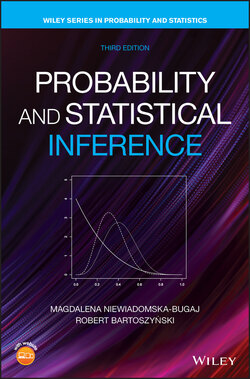Читать книгу Probability and Statistical Inference - Robert Bartoszynski - Страница 57
Solution
ОглавлениеThe best strategy for solving this kind of problem is finding the probabilities of all the intersections (in this case, ). The probability is given. Next, , and the events on the left are disjoint. So which means that , and hence, . Then, using , we have ; hence, . similarly . Applying formula (2.3), we have
For the case of three events: and , the same argument based on Venn diagrams gives the formula
(2.5)
It can be checked at Figure 2.7 that the formula (2.5) includes each part of the union exactly once.
Figure 2.7 Union of three events.
Formula (2.5) may be generalized to the case of the union of any finite number of events.
Theorem 2.4.1 For any events
(2.6)
Proof: We will proceed by induction. The theorem is true for . Assume now that formula (2.6) holds, and write
Since
we have
Applying formula (2.6) to and to , and then combining the corresponding terms, we obtain (2.6) with replaced by .
